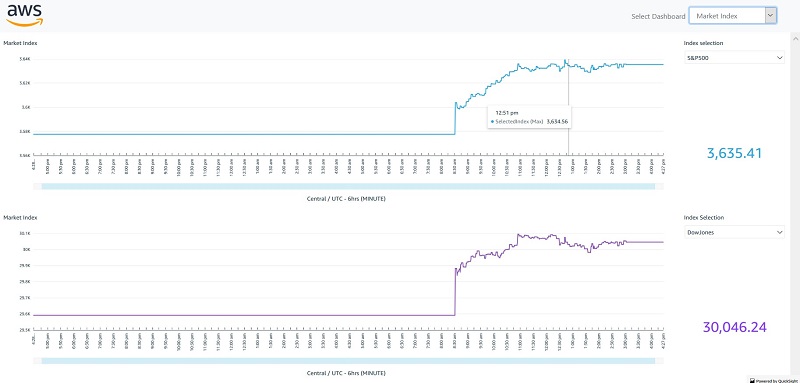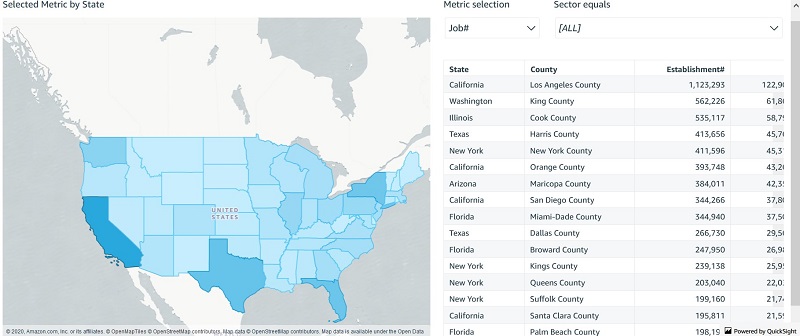AWS Big Data Blog
New in Amazon QuickSight – session capacity pricing for large scale deployments, embedding in public websites, and developer portal for embedded analytics
Amazon QuickSight Enterprise edition now offers a new, session capacity-based pricing model starting at $250/month, with annual commitment options that provide scalable pricing for embedded analytics and BI rollouts to 100s of 1000s of users. QuickSight now also supports embedding dashboards in apps, websites, and wikis without the need to provision and manage users (readers) in QuickSight, which utilizes this new pricing model. Lastly, we also have a new developer portal for embedded analytics that allows you to learn more about the different embedded solutions available with QuickSight and experience it first-hand.
Session Capacity Pricing
Amazon QuickSight’s new session capacity-based pricing model provides scalable pricing for large scale deployments. Session capacity pricing allows Developers, Independent Software Vendors (ISVs) and Enterprises to benefit from lower per-session rates as they roll out embedded analytics and BI to 100s of 1000s of users. In such scenarios, average session consumption per user is usually low (<10 sessions/month) but aggregate session usage across users within the account is high. With session capacity pricing, sessions are simply charged in 30-minute blocks of usage starting with first access. Session capacity pricing is also required for embedding without user management, where per-user pricing is not meaningful. Unlike traditional options for capacity pricing which require a server with annual commitments, QuickSight’s session capacity pricing allows you to get started easily with a $250/month starter option. QuickSight’s session capacities do not slow down with increased user concurrency or higher analytical complexity of dashboards (both common in a server-based model), but instead automatically scale to ensure a consistent, fast, end-user experience. After starting with the monthly option, you can move to one of QuickSight’s annual session capacity tiers as your sessions usage increases – ensuring that costs scale with growing usage. Any usage beyond the committed levels (monthly or annual) is charged at the overage session rates indicated, with no manual intervention for scaling needed – no more scrambling to add servers as you have bursts in usage or just greater success with your application/website. Annual session capacities are billed for monthly usage of sessions, with consumption of all committed sessions expected by end of the period. Annual session capacities allow sessions to be consumed across the year, providing flexibility in ramping up on production traffic, balancing session needs across busy/lean periods of the year (e.g., first/last week of the month are busy, holidays may be slow or busy depending on the nature of the business). For more details on the new pricing options, visit the QuickSight pricing page.

Embedding in public websites and portals
Before this launch, Amazon QuickSight provided embedding dashboards in apps and portals where each end-user could be identified and provisioned in QuickSight, and charged using QuickSight’s per-user pricing model. This works well for situations where each end user can be uniquely identified, and often has permissions associated with their data access levels. The NFL chose QuickSight to embed dashboards in their next-gen stats portal and share insights with clubs, broadcasters and editorial teams. 1000s of customers have since chosen to launch embedded dashboards in QuickSight for both their internal and external end-users, including Blackboard, Comcast, Panasonic Avionics, EHE Health. Customers can scale from 10s of users to 100s of 1000s without any server provisioning or management and also benefit from being able to utilize embedded QuickSight authoring capabilities to enable self-service dashboard creation.
With today’s launch, QuickSight will now also enable use cases with dashboards for 100s of 1000s of readers, where it is not possible to provision and manage users (or is highly inconvenient to do so).
Examples of these situations include embedded dashboards for sharing public statistics within a city/county, dashboards of company-wide statistics available to all users to be embedded on an internal corporate portal, or embedded dashboards with the same data intended for 10s or 1000s of users per customer, department or job location/site within an app.
Let’s take a look at a couple of examples and then how to embed these dashboards. First, a dashboard that shows a live stream of the three main stock indices (S&P 500, DOW Jones, and NASDAQ) that uses QuickSight’s newly launched connector to Amazon Timestream to provide a real-time view of the market index in US Central Time.
Second, a dashboard showing industries and count of firms in those industries using a choropleth map at the state level with the ability to drill down to county-level data.
Both dashboards are setup so that they can be accessed without any user restrictions, and we don’t have to setup users to roll this out. You can see these dashboards accessible for anyone here. To try this out, you can use the AWS Command Line Interface (AWS CLI); note that the AWS CLI used here is simply to illustrate this process, and for actual integration into a website/app you have to use the AWS SDK to obtain an embeddable URL for every new visit to the page.
4 steps to embed a dashboard
- Configure an AWS Identity and Access Management (IAM) role for your application to use for embedding
- Attach the following policy to the role so the role can run the
GetDashboardEmbedURLAPI for anonymous identity type: - Run the
GetDashboardEmbedURLAPI withIdentityTypeset toANONYMOUS. This returns a response with the EmbedURL:
You can embed the returned URL in the IFRAME code of your application. Make sure your application is added to the allow list in QuickSight. This is a single-use URL and has to be generated dynamically by invoking get-dashboard-embed-url from the backend compute layer upon each load of the parent page.
- Embed the dashboard in your application with the following HTML code:
If you use NPM to manage you front end dependencies, run npm install amazon-quicksight-embedding-sdk. And then you can add use the following code to embed the URL in your application:
If you want to embed multiple dashboards and switch between them, you can pass more dashboard IDs by using the additional-dashboard-ids option while generating the URL. This generates the URL with authorization for all specified dashboard IDs and launches the dashboard specified under the dashboard-id option. See the following code:
In the preceding code, we assign our primary dashboard’s ID to the --dashboard-id option, and the other dashboard IDs to the --additional-dashboard-ids option as a space-separated value. You can pass up to 20 dashboard IDs in this option.
The EmbedURL value in the response is the URL for the primary dashboard. You can embed this dashboard in your app, wiki, or website and use the JavaScript SDK to switch between dashboards. To switch to another dashboard without having to generate a fresh embed URL, invoke the navigateToDashboard function (available in our JavaScript library) with any of the dashboard IDs that were initially included in the get-dashboard-embed-url call. See the following example code:
For more information about the JavaScript SDK, see the GitHub repo.
Embedding without users is now generally available to all Amazon QuickSight Enterprise Edition users and requires session capacity pricing.
To opt-in for session capacity pricing and embed dashboards without user provisioning, or simply enable discounted QuickSight usage for large scale deployments, you can opt-into session capacity pricing starting with the $250/month option via the “Manage QuickSight” > “Your subscriptions” page accessible to QuickSight administrators.

Embedded Developer Portal
We have a new embedded developer portal at https://developer.quicksight.aws that allows you to quickly interact with three key embedded scenarios – 1) embedded dashboards accessible to anyone accessing a website or portal (no user provisioning required), 2) embedded dashboards accessible to only authenticated users, and 3) embedded dashboard authoring for power users of apps.

The interactive dashboards, code snippets and setup instructions allow you to learn more about the rich capabilities of QuickSight embedding, easily get started with embedding QuickSight.

Summary
With new embedding capability, QuickSight offers a modern, serverless approach to deploying dashboards and visualizations into websites, apps and corporate portals in hours, without any user provisioning or management needed to scale to 100s of 1000s of users. Unlike traditional server-based models, QuickSight’s session capacity model allows you to start at a low $250/month, month-to-month price point. As usage grows, the available annual commitment models offer scalable pricing by reducing the per-session cost – enabling both ISVs and Enterprises to roll out embedded QuickSight dashboards at large scale, whether for internal or external users. Finally, with QuickSight’s new developer portal, you have instant access to samples of interactive embedded QuickSight dashboards as well as steps to integrating various embedded capabilities into your own websites, apps and portals.
About the Authors
 Jose Kunnackal John is Sr. Manager for Amazon QuickSight, AWS’ cloud-native, fully managed BI service. Jose started his career with Motorola, writing software for telecom and first responder systems. Later he was Director of Engineering at Trilibis Mobile, where he built a SaaS mobile web platform using AWS services. Jose is excited by the potential of cloud technologies and looks forward to helping customers with their transition to the cloud.
Jose Kunnackal John is Sr. Manager for Amazon QuickSight, AWS’ cloud-native, fully managed BI service. Jose started his career with Motorola, writing software for telecom and first responder systems. Later he was Director of Engineering at Trilibis Mobile, where he built a SaaS mobile web platform using AWS services. Jose is excited by the potential of cloud technologies and looks forward to helping customers with their transition to the cloud.
 Kareem Syed-Mohammed is a Product Manager at Amazon QuickSight. He focuses on embedded analytics, APIs, and developer experience. Prior to QuickSight he has been with AWS Marketplace and Amazon retail as a PM. Kareem started his career as a developer and then PM for call center technologies, Local Expert and Ads for Expedia. He worked as a consultant with McKinsey and Company for a short while.
Kareem Syed-Mohammed is a Product Manager at Amazon QuickSight. He focuses on embedded analytics, APIs, and developer experience. Prior to QuickSight he has been with AWS Marketplace and Amazon retail as a PM. Kareem started his career as a developer and then PM for call center technologies, Local Expert and Ads for Expedia. He worked as a consultant with McKinsey and Company for a short while.
 Arun Santhosh is a Specialized World Wide Solution Architect for Amazon QuickSight. Arun started his career at IBM as a developer and progressed on to be an Application Architect. Later, he worked as a Technical Architect at Cognizant. Business Intelligence has been his core focus in these prior roles as well
Arun Santhosh is a Specialized World Wide Solution Architect for Amazon QuickSight. Arun started his career at IBM as a developer and progressed on to be an Application Architect. Later, he worked as a Technical Architect at Cognizant. Business Intelligence has been his core focus in these prior roles as well

